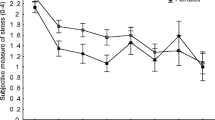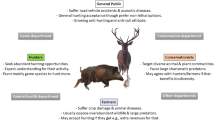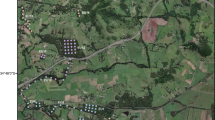Abstract
Many populations of wildlife, including large- and medium-sized predators are increasing in Europe. Trapping can be one way to reduce negative impacts of predators on human interests, such as game species and threatened species, but there is little knowledge of trap usage and motivation behind it. We used a mail survey in Sweden (n = 3,886 respondents) to compare predator trappers with hunters who used other methods to kill predators, and with other hunters who did not kill predators, in regard to sociodemographics, beliefs, behaviors, and constraints. During 12 months prior to the survey 19 % of respondents had trapped any small- or medium-sized predator, while 15 % of respondents had trapped and 55 % had hunted (without using traps) red fox (Vulpes vulpes), European badger (Meles meles), or corvid birds. Reducing predator numbers was an important reason for hunting predators with traps. Of predator trappers, 97 % had hunted species that were potentially prey of the targeted predators (e.g., roe deer [Capreolus capreolus], hare [Lepus spp.], and grouse), 94 % believed that there were too many red foxes, badgers, or corvids on their main hunting ground, and 64 % believed it to be very important to reduce predator numbers to benefit other game species. We conclude that the use of traps is widespread among Swedish hunters, and that increasing wildlife populations, increased presence of wildlife in urban areas, and management of invasive species calls for effective management actions, of which trapping can be one.

Similar content being viewed by others
References
Ajzen I (2005) Attitudes, personality and behavior, 2nd edn. Open University Press, Maidenhead
Andrén H (1992) Corvid density and nest predation in relation to forest fragmentation: a landscape perspective. Ecology 73:794–804
Angerbjörn A, Eide NE, Dalén L, Elmhagen B, Hellström P, Ims RA, Killengreen S, Landa A, Meijer T, Mela M, Niemimaa J, Norén K, Tannerfeldt M, Yoccoz NG, Henttonen H (2013) Carnivore conservation in practice: replicated management actions on a large spatial scale. J Appl Ecol 50:59–67
Armitage CJ, Conner M (2001) Efficacy of the theory of planned behavior: a meta-analytic review. Br J Sociol 40:471–499
Backman SJ, Wright BA (1993) An explanatory study of the relationship of attitude and the perception of constraints to hunting. J Park Recreat Admi 11:1–16
Bergström R, Danell K (2009) Trenden tydlig, mer vilt idag än för 50 år sedan. Vilt och fisk fakta. Swedish University of Agricultural Sciences, Umeå
Bjerke T, Reitan O, Kellert SR (1998) Attitudes toward wolves in southeastern Norway. Soc Natur Resour 11:169–178
Bolton M, Tyler G, Smith K, Bamford R (2007) The impact of predator control on lapwing Vanellus vanellus breeding success on wet grassland nature reserves. J Appl Ecol 44:534–544
Bonnaud E, Zarzoso-Lacoste D, Bourgeois K, Ruffino L, Legrand J, Vidal E (2010) Top-predator control on islands boosts endemic prey but not mesopredator. Anim Conserv 13:556–567
Carlsson NL, Jeschke J, Holmqvist N, Kindberg J (2010) Long-term data on invaders: when the fox is away, the mink will play. Biol Invasions 12:633–641
Chiron F, Julliard R (2013) Assessing the effects of trapping on pest bird species at the country level. Biol Conserv 158:98–106
Cohen J (1988) Statistical power analysis for the behavioral sciences, 2nd edn. Lawrence Erlbaum Associates, Hillsdale
Conover MR (2002) Resolving human–wildlife conflicts: the science of wildlife damage management. Lewis Publishers, Boca Raton
Côté IM, Sutherland WJ (1997) The effectiveness of removing predators to protect bird populations. Conserv Biol 11:395–405
Dahl F, Åhlén P-A (2013) Mårdhundsprojektet – lägesrapport 2013. Swedish University of Agricultural Sciences. Uppsala, Sweden
Daigle JJ, Muth RM, Zwick RR, Glass RJ (1998) Sociocultural dimensions of trapping: a factor analytic study of trappers in six northeastern states. Wildlife Soc B 26:614–625
Danell K, Bergström R (2005) Framtidens lösen för jägaren är viltvård": om viltvården under 1900-talet. In: Akerberg S (ed) Viltvård, älgar och jaktturism: tvärvetenskapliga perspektiv på jakt och vilt i Sverige 1830–2000. Nyheternas tryckeri, Umeå, pp 36–73
Decker DJ, Riley SJ, Siemer WF (2012) Human dimensions of wildlife management. In: Decker DJ, Riley SJ (eds) Siemer (eds) Human dimensions of wildlife management, 2nd edn. John Hopkins University Press, Baltimore, pp 3–14
Deinet S, Leronymidou C, McRae L, Burfield IJ, Foppen RP, Collen B, Böhm M (2013) Wildlife comeback in Europe: the recovery of selected mammal and bird species. Final report to Rewilding Europe by Zoological Society of London. BirdLife International and the European Bird Census Council, London
Delibes-Mateos M, Diaz-Fernandez S, Ferreras P, Vinuela J, Arroyo B (2013) The role of economic and social factors driving predator control in small-game estates in central Spain. Ecol Soc 18:28. doi:10.5751/ES-05367-180228
Díaz-Ruiz F, García JT, Pérez-Rodríguez L, Ferreras P (2010) Experimental evaluation of live cage-traps for black-billed magpies Pica pica management in Spain. Eur J Wildl Res 56:239–248
Dillman DA, Smyth JD, Christian LM (2009) Internet, mail, and mixed-mode surveys: the tailored design method, 3rd edn. Wiley, Hoboken
Donnelly MP, Vaske JJ (1995) Predicting attitudes toward a proposed moose hunt. Soc Natur Resour 8:307–319
Duda MD, Young KC (1998) American attitudes toward scientific wildlife management and human use of fish and wildlife: implications for effective public relations and communications stratefies. Trans 63rd N Am Wildl Nat Resour Conf
Erlinge S, Frylestam B, Göransson G, Högstedt G, Liberg O, Loman J, Nilsson IN, von Schantz T, Sylvén M (1984) Predation on brown hare and ring necked pheasant populations in southern Sweden. Holarctic Ecol 7:300–304
Farago S (2001) Dynamics of a Grey Partridge (Perdix perdix) population in western Hungary: effect of a management plan. Game Wildl Sci 18:425–441
Gren IM, Carlsson M (2012) Revealed payments for biodiversity protection in Swedish forests. Forest Policy Econ 23:55–62
Hampshire K, Bell S, Wallace G (2004) “Real” poachers and predators: shades of meaning in local understandings of threats to fisheries. Soc Natur Resour 17:305–318
Harding EK, Doak DF, Albertson JD (2001) Evaluating the effectiveness of predator control: the non-native red fox as a case study. Conserv Biol 15:1114–1122
Heberlein TA (2012) Navigating environmental attitudes. Conserv Biol 26:583–585
Heydon MJ, Reynolds JC (2000) Fox (Vulpes vulpes) management in three contrasting regions of Britain, in relation to agricultural and sporting interests. J Zool 251:237–252
Heydon MJ, Wilson CJ, Tew T (2010) Wildlife conflict resolution: a review of problems, solutions and regulation in England. Wildl Res 37:731–748
Hounsome T, Delahay R (2005) Birds in the diet of the Eurasian badger Meles meles: a review and meta-analysis. Mammal Rev 35:199–209
Iossa G, Soulsbury CD, Harris S (2007) Mammal trapping: a review of animal welfare standards of killing and restraining traps. Anim Welfare 16:335–352
Isaksson D (2008) Predation and shorebirds: predation management, habitat effects, and public opinions. Dissertation, University of Gothenburg
Kauhala K, Kowalczyk R (2011) Invasion of the raccoon dog Nyctereutes procyonoides in Europe: history of colonization, features behind its success, and threats to native fauna. Curr Zool 57:584–598
Kindberg J, Holmqvist N, Bergqvist G (2009) Årsrapport 2007–2008, viltövervakningen, Öster Malma, Sweden
Koval MH, Mertig AG (2004) Attitudes of the Michigan public and wildlife agency personnel toward lethal wildlife management. Wildl Soc B 32:232–243
Lavers JL, Wilcox C, Donlan CJ (2010) Bird demographic responses to predator removal programs. Biol Invasions 12:3839–3859
Levinsky I, Skov F, Svenning J-C, Rahbek C (2007) Potential impacts of climate change on the distributions and diversity patterns of European mammals. Biodivers Conserv 16:3803–3816
Lindström ER, Andrén H, Angelstam P, Cederlund G, Hörnfeldt B, Jäderberg L, Lemnell P-A, Martinsson B, Sköld K, Swenson JE (1994) Disease reveals the predator: sarcoptic mange, red fox predation, and prey populations. Ecology 75:1042–1049
Ljung PE, Riley JR, Ericsson G (2014) Game meat consumption feeds urban support of traditional use of natural resources. Soc Natur Resour
MacDonald MA, Bolton M (2008) Predation on wader nests in Europe. Ibis 150:S54–S73
Manfredo MJ, Pierce CL, Fulton D, Pate J, Gill BR (1999) Public acceptance of wildlife trapping in Colorado. Wildlife Soc B 27:499–508
Marcström V, Kenward RE, Engren E (1988) The impact of predation on boreal tetraonids during vole cycles: an experimental study. J Anim Ecol 57:859–872
Martínez-Espiñeira R (2006) Public attitudes toward lethal coyote control. Hum Dimens Wildl 11:89–100
Miller C, Vaske J (2003) Individual and situational influences on declining hunter effort in Illinois. Hum Dimens Wildl 8:263–276
Minnis DL (1998) Wildlife policy-making by the electorate: an overview of citizen-sponsored ballot measures on hunting and trapping. Wildl Soc B 26:75–83
Moberly RL, White PCL, Webbon CC, Baker PJ, Harris S (2003) Factors associated with fox (Vulpes vulpes) predation of lambs in Britain. Wildl Res 30:219–227
Moore N, Whiterow A, Kelly P, Garthwaite D, Bishop J, Langton S, Cheeseman C (1999) Survey of badger Meles meles damage to agriculture in England and Wales. J Appl Ecol 36:974–988
Nyaupane GP, Morais DB, Graefe AR (2004) Nature tourism constraints: a cross-activity comparison. Ann Tourism Res 31:540–555
Pacelle W (1998) Forging a new wildlife management paradigm: integrating animal protection values. Hum Dimens Wildl 3:42–50
Panzacchi M, Linnell JDC, Serrao G, Eie S, Odden M, Odden J, Anderson R (2008) Evaluation of the importance of roe deer fawns in the spring–summer diet of red foxes in southeastern Norway. Ecol Res 23:889–896
Pyka M, Nyqvist A, Monstad T, Hagstedt J, Korsell L (2007) Illegal jakt på stora rovdjur: konflikt i laglöst land? Brottsförebyggande rådet. Edita Norstedts, Västerås, Sverige
Reynolds JC (2004) Trade-offs between welfare, conservation, utility and economics ni wildlife management – a review of conflicts, compromises and regulation. Anim Welfare 13:S133–S138
Reynolds JC, Tapper SC (1996) Control of mammalian predators in game management and conservation. Mammal Rev 26:127–156
Reynolds JC, Stoate C, Brockless MH, Aebischer NJ, Tapper SC (2010) The consequences of predator control for brown hares (Lepus europaeus) on UK farmland. Eur J Wildl Res 56:541–549
Rodríguez A, Delibes M (2004) Patterns and causes of non-natural mortality in the Iberian lynx during a 40-year period of range contraction. Biol Conserv 118:151–161
Salo P, Banks PB, Dickman CR, Korpimäki E (2010) Predator manipulation experiments: impacts on populations of terrestrial vertebrate prey. Ecol Monogr 80:531–546
Schütz KE, Ågren E, Amundin M, Röken B, Palme R, Mörner T (2006) Behavioral and physiological responses of trap-induced stress in European badgers. J Wildl Manage 70:884–891
Seiler A (2004) Trends and spatial patterns in ungulate–vehicle collisions in Sweden. Wildl Biol 10:301–313
Short MJ, Weldon AW, Richardson SM, Reynolds JC (2012) Selectivity and injury risk in an improved neck snare for live-capture of foxes. Wildl Soc B 36:208–219
Statistics Sweden (2010) Tables on the population in Sweden 2009. Örebro, Sweden
Swedish Environmental Protection Agency (Swedish EPA) (2012) Extract from the Swedish hunting register. Östersund, Sweden
Talling JC, Inglis IR (2009) Improvements to trapping standards. The Directorate-General for the Environment. http://ec.europa.eu/environment/biodiversity/animal_welfare/hts/pdf/final_report.pdf. Accessed 30 Oct 2013
Virgós E, Travaini A (2005) Relationship between small-game hunting and carnivore diversity in central Spain. Biodiverse Conserv 14:3475–3486
White PCL, Newton-Cross GA, Moberly RL, Smart JCR, Baker PJ, Harris S (2003) The current and future management of wild mammals hunted with dogs in England and Wales. J Environ Manage 67:187–197
Wilmers CC, Levi T (2013) Do irrigation and predator control reduce the productivity of migratory ungulate herds? Ecology 94:1264–1270
Acknowledgements
The research was jointly funded by The Swedish Association for Hunting and Wildlife Management and the Faculty of Forest Sciences at the Swedish University of Agricultural Sciences (SLU). We thank A. Fischer and two anonymous reviewers for valuable comments and suggestions, and A. Kagervall and S. Ljung for helpful discussions, and useful comments on the manuscript
Author information
Authors and Affiliations
Corresponding author
Additional information
Communicated by H. Kierdorf
Rights and permissions
About this article
Cite this article
Ljung, P.E., Widemo, F. & Ericsson, G. Trapping in predator management: catching the profile of trap users in Sweden. Eur J Wildl Res 60, 681–689 (2014). https://doi.org/10.1007/s10344-014-0837-9
Received:
Revised:
Accepted:
Published:
Issue Date:
DOI: https://doi.org/10.1007/s10344-014-0837-9




